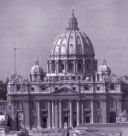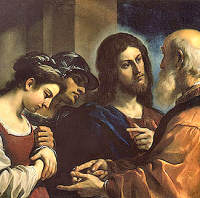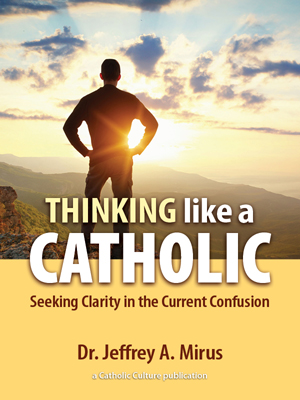» Enjoy our Liturgical Seasons series of e-books!
"Let the one among you who is without sin be the first to throw a stone at her." Jesus did not deny the Scribes and Pharisees the right to carry out this prescription of the Law, but He insisted on one condition, namely, that they have no sin on their consciences. When Jesus and the woman were left alone, He looked up and said, "Woman, where are they?" Ironically, the self-righteous observers of the Law, so eager to throw stones, could not measure up to the requirement that Jesus had laid down.
Previously called "Passion Sunday," this Sunday marks the beginning of Passiontide, a deeper time of Lent. This is the third Sunday of the scrutinies for the preparation of adult converts, and the final Sunday of Lent before the beginning of Holy Week. The Liturgy of the Word of this day speaks of re-creation, resurrection, and new life.

At Rome, the Station is in the basilica of St. Peter. The importance of this Sunday, which never yields to any feast no matter what its solemnity may be, requires that the place for the assembly of the faithful should be in one of the chief sanctuaries of the holy city.
Sunday Readings
The selection from the Old Testament prophet Ezekiel 37:12-14 is taken from the chapter about pouring forth the Spirit upon the "dry bones" in the valley of his vision. The prophet speaks of restoration through an act of God through the Spirit and that it was through him that the people first were saved from their oppression in Egypt, and by his power they will be saved again and restored as the people of God. The symbolic meaning of the reading is the resurrection of the people to new life, a theme clearly reiterated in succeeding apocalyptic literature and finally present in the death and resurrection of Jesus.
The reading from St Paul to the Romans 8:8-11 states that through Christ the whole person of the believer is saved, raised up, and redeemed. The realm of the flesh is the realm to be left behind, and the realm of the Spirit is where true life is to be found. But there is no hellenistic dichotomy here between flesh and spirit since the believer lives with the Spirit of God enfleshed in his body so that his whole person will live in conformity with that Spirit. The indwelling of the Spirit refers to the baptism of the person and his consequent moral life.
The gospel reading, St. John 11:1-45, brings to a climax the Johannine discourses of the third, fourth, and fifth Sundays of Lent—the accounts of the Samaritan woman, the man born blind, and the raising of Lazarus. As in the previous discourses, the deeper level of meaning lies in the additions to the narrative by the sacred author and these should be explored completely. The narration of the story gives way to the statement of Jesus that "I am the resurrection and the life" and that belief is necessary if a person wishes to save his life.
The scandal of the cross is that He who is the Resurrection and the Life first had to suffer and die before men could live, for only by dying could He then be raised to new life with the Father. In baptism the believer dies to his former self and former way of life, and rises to the newness of life in Christ Jesus. — A Celebrants Guide to the New Sacramentary - A Cycle by Kevin W. Irwin

Fifth Sunday of Lent
Station with San Pietro in Vaticano (St. Peter in the Vatican):
In the 1962 Roman Missal, this would be Passion Sunday. All Station Churches for Sundays in Lent were held at basilicas of Rome, but the major basilicas particularly for the first, fifth and sixth Sundays of Lent. The original church was erected on the site of the Roman Circus built by the Emperor Caligula around the year A.D. 40. and where St. Peter was crucified and placed upside down at his request and later buried here.
From the PNAC: "Rightly has Pope Benedict XVI spoken of this basilica as the heart of the Roman Church, as St. John Lateran is the head. It is here that the Church honors her first shepherd in this city, and here that since his martyrdom she has celebrated both his witness and the God he served. While the basilica before us is relatively modern as far as the history of Christianity goes, being completed only in 1626, Christians have been coming to this site to ask for his intercession since shortly after the death of the Prince of the Apostles, as messages left by them on the wall of his grave attest."
For more on San Pietro in Vaticano, see:
- Rome Art Lover
- Roman Churches
- PNAC
- Aleteia
- St. Peter's Basilica Info
- Station Church
- The Catholic Traveler
For further information on the Station Churches, see The Stational Church.






